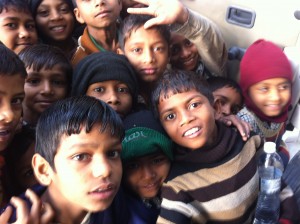For my final blog entry I want to reflect a little bit further on my experience during the two weeks that I spent in Gujarat. The entire tour was an eye-opening and life changing experience. It was my first time visiting a new country and traveling to a new continent. I wasn’t sure what to expect and I was quite nervous. While I have traveled before, I was told that nothing could prepare me for India and, particularly with the topic that we were researching, I knew that it was going to be a very intense experience.
Upon my arrival to India, my first experience was an unforgettable taxi ride from the Ahmedabad airport to the hotel we were staying in. That ride seemed to confirm everything that I had been told about India. I wasn’t sure if I was going to make it to the hotel alive as the driver courageously and aggressively blew through every intersection. The traffic lights in the intersections themselves were just flashing a yellow light, an unheeded reminder to slow down and be careful. But I also saw beautiful murals, an elephant walking down a busy city street, and children flying kites. I knew that India would be intense, in-your-face, and require a lot of cultural adjustments, but I was also extremely excited about the fantastic and beautiful new land that I was going to visit.
The remainder of my visit didn’t disappoint at all. The trip was tiring but we had an incredible opportunity to meet with many different individuals on many different levels of society that were all, in some way, affected by the 2002 violence. While we heard many tragic and awful stories that could have colored my opinion of India in general, I tried to understand all of the complexities of the society and not let what we were examining completely tarnish my image of the whole country. All of these meetings and experiences helped to give me a very strong, first-hand understanding of the reality on the ground in Gujarat. While this understanding was naturally inadequate, given that I only had two weeks in country, it allowed me to scratch the surface of a critical situation in a way that I never had before.
While the trip was tough, both physically and emotionally, it was an absolutely unforgettable experience. On a personal and professional level I feel that I grew enormously with the exposure that I had both to a new culture and to the tragic reality of the 2002 communal violence/genocide and its aftermath. Even though the picture that I got in Gujarat was far from rosy, I met with many inspirational people doing fantastic work. Additionally, I was very much intrigued and fascinated by the colorful, energetic culture, and I loved the delicious cuisine. This entire trip, and the research and work I did both before and after the actual excursion, will be a completely unforgettable experience for me. I would love to go back to India one day and learn more about what this fascinating country and culture has to offer.


![254924_220008461351207_6499979_n[1]](http://sites.miis.edu/ccsingujarat2013/files/2013/01/254924_220008461351207_6499979_n1-206x300.jpg)

